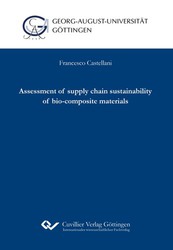| Departments | |
|---|---|
| Book Series (96) |
1379
|
| Nachhaltigkeit |
3
|
| Gesundheitswesen |
1
|
| Humanities |
2367
|
| Medienwissenschaften | 16 |
| Theology | 57 |
| Philosophy | 102 |
| Law | 422 |
| Economics | 851 |
| Social sciences | 416 |
| Sports science | 48 |
| Psychology | 233 |
| Educational science | 190 |
| History | 183 |
| Art | 111 |
| Cultural studies | 166 |
| Literary studies | 117 |
| Linguistics | 88 |
| Natural Sciences |
5407
|
| Engineering |
1793
|
| Common |
98
|
|
Leitlinien Unfallchirurgie
5. Auflage bestellen |
|
Advanced Search
Assessment of supply chain sustainability of bio-composite materials (English shop)
Francesco Castellani (Author)Preview
Extract, PDF (340 KB)
Table of Contents, PDF (67 KB)
Industrial processes are currently based on considerable consumption of fossil resources. Bringing down the level of greenhouse gases emitted into the atmosphere when extracting and processing these kind of resources has been main driver for the development of fossil resources substitutes and for the adoption of strategies to promote their efficient use. To increase business competitiveness, to optimize the supply chain, and to increment product quality, decision-makers of the horticulture segment face the problem to choose between fossil-based resources and their substitutes. This dissertation presents an Operations Research model, developed for decision-making support in horticulture. The model determines optimal mixture of growth substrate (composed by peat and olive-mill waste compost) and optimal material of planter container (made of petroleum-based plastic or biodegradable, biopolymer), such that additional costs when substituting and environmental impacts of a potted plant are simultaneously minimized. The optimization model is applied to a case study in Italy. Here, greenhouse gases emitted by organic compounds are detected with experimental trials, the agronomic quality of potted plants is investigated, Life Cycle Assessment is performed, and decision-relevant costs are examined. The bi-objective problem is addressed using Pareto optimization. Finally, a scenario analysis investigates the variation of the outcomes by using different input parameters, in order to give a broader image of optimal solutions.
Industrielle Produktionssysteme basieren derzeit auf einem erheblichen Verbrauch fossiler Ressourcen. Die Reduzierung der Treibhausgasemissionen, die bei der Gewinnung und Verarbeitung dieser Ressourcen in die Atmosphäre gelangen, ist ein Haupttreiber für die Entwicklung von Substituten für fossile Rohstoffe und für die Umsetzung von Strategien, die die effiziente Nutzung dieser Substitute vorantreiben. Um die Wettbewerbsfähigkeit der Unternehmen zu stärken, die Lieferkette zu optimieren und die Produktqualität zu steigern, stehen Entscheider in der Gartenbaubranche vor der Problematik, zwischen fossilen Ressourcen und ihren Substituten zu wählen. In dieser Dissertation wird ein Modell des Operations Research zur Entscheidungsunterstützung für Unternehmen in der Gartenbaubranche entwickelt. Das Modell bestimmt die optimale Mischung von Wachstumssubstrat (welches sich aus Torf und Kompost aus Abfällen einer Olivenmühle zusammensetzt) und optimalem Material für den Topf (Kunststoff auf Erdölbasis oder aus biologisch abbaubarem Biopolymer), so dass die entscheidungsrelevanten Kosten und Emissionen einer Topfpflanze gleichzeitig minimiert werden. Das Optimierungsmodell wird auf eine Fallstudie in Italien angewendet. Dabei werden Treibhausgasemissionen von Kompost mithilfe von Experimenten erfasst, die agronomische Qualität von Topfpflanzen untersucht, eine Ökobilanzierung durchgeführt und entscheidungsrelevante Kosten untersucht. Für das bikriterielle Problem werden Pareto-optimale Lösungen gefunden. Schließlich wird die Reaktion der Ergebnisse auf die Verwendung verschiedener Eingabeparameter mithilfe einer Szenarioanalyse untersucht, um ein breiteres Bild der optimalen Lösungen zu erhalten.
| ISBN-13 (Hard Copy) | 9783736998308 |
| ISBN-13 (eBook) | 9783736988309 |
| Final Book Format | A5 |
| Language | English |
| Page Number | 164 |
| Lamination of Cover | glossy |
| Edition | 1. |
| Publication Place | Göttingen |
| Place of Dissertation | Göttingen |
| Publication Date | 2018-07-16 |
| General Categorization | Dissertation |
| Departments |
Economics
|
| Keywords | peat, compost, olive mill waste, horticulture, agriculture, optimization, climate protection, greenhouse gas emissions, experimental detection, environmental impacts, decision-relevant costs, Life Cycle Assessment, Pareto, biopolymer, polylactic acid, supply chain, sustainability, bio-composite material, quality assessment, mixing problem, bio-pot, scenario analysis, resource efficiency, cascade utilization |








